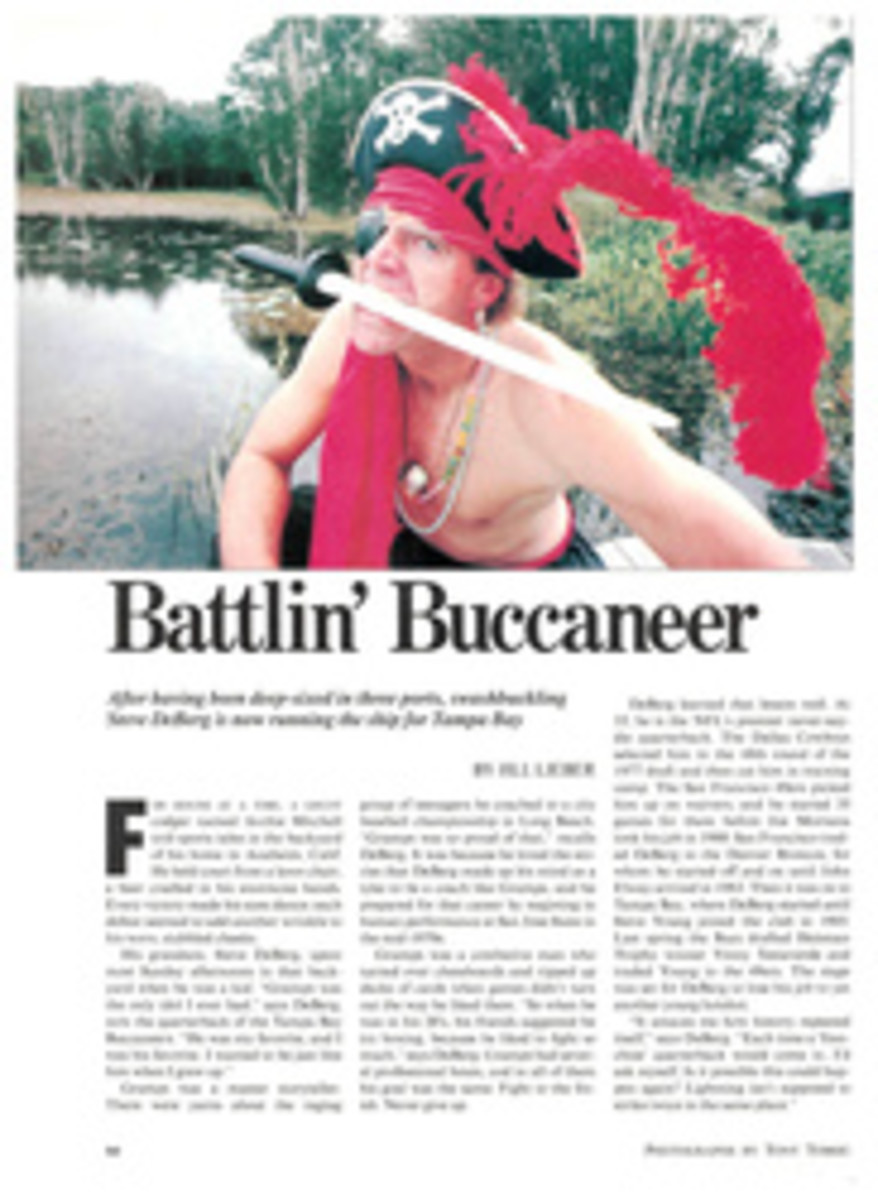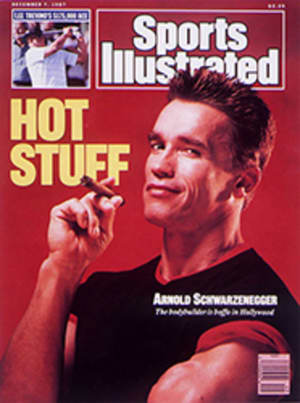
A HALF-SEASON HEISMAN
When Angelo Bertelli arrived in South Bend in the fall of 1940, he found life as a Notre Dame freshman, particularly life on the gridiron, to be not all that he had anticipated. The Irish, under coach Elmer Layden, employed the famed Notre Dame box, a Knute Rockne-created offense that—like the single wing, which Layden occasionally used—relied upon the running skills of either the tailback or the fullback. Bertelli, who had been celebrated as the Arm while passing Cathedral High School in Spring-field, Mass., to a Western Massachusetts championship in 1939, had never shown much inclination or talent for lugging the pigskin. Now he found himself listed as fourth-string tailback on the freshman team, and he resigned himself to the fact that there was no room in big-time football for a stringy (6'1", 170 pounds) back who preferred passes to plunges. Today he admits that "had Elmer Layden stayed at Notre Dame, I don't think I ever would have made the traveling squad."
But at the end of Bertelli's freshman season, Layden became commissioner of the 10-team National Football League, and Frank Leahy succeeded him. Leahy came to South Bend fresh from an undefeated season at Boston College (the Eagles had a 20-2 overall record in Leahy's two seasons as head coach). Leahy knew all about Bertelli. Two years earlier he had dispatched his assistant, the silver-tongued Ed McKeever, to try to persuade Bertelli to play at Chestnut Hill. Bertelli had avoided McKeever at the time by taking in a double feature at the local movie house, leaving McKeever to deal with his mother, an Italian immigrant who spoke little English. Now, at Notre Dame, Leahy had his man.
During the summer of 1941 Bertelli earned 50 cents an hour helping to put two coats of paint on each of the 54,000 seats in Notre Dame Stadium. When fall came and he turned in his brush for a leather helmet, he had vaulted to the top of the depth chart. Leahy was convinced that an offense became twice as potent if it could consistently gain yards in the air as well as on the ground. Consequently, he committed single wing heresy by making Bertelli, never even an average runner, his tailback. "Who ever heard of a tailback that didn't run with the ball?" says Bertelli. "But I spent that season just handing off to Dippy Evans or passing."
Unorthodox or not, the strategy worked, as Notre Dame rolled to an 8-0-1 season, the only nonvictory being a scoreless midseason tie with powerful Army. Bertelli completed an unheard-of 57% of his passes and finished second, to Minnesota's halfback Bruce Smith, in the Heisman voting. Almost as high an honor was the compliment, of sorts, he received from Leahy. "Bert," Leahy told him, "you are the finest passer and the worst runner I've ever coached."
Leahy knew he couldn't continue to fool opposing defenses with a tailback who couldn't run, so between seasons he discarded Rockne's Notre Dame box. In the winter of 1941-42, on the Notre Dame gym floor, Leahy began to teach his players the intricacies of the T formation, the new offense that George Halas of the Chicago Bears had developed in conjunction with University of Chicago coach Clark Shaughnessy. On the hardwood floor, Leahy showed running backs how to split behind the quarterback and drilled Bertelli in a variety of spins, fakes and pitches. The rehearsals paid off. During the '42 season Grantland Rice wrote that Bertelli was the greatest faker he had ever seen. But early on it appeared the team as a whole might be a bit of a sham. The Irish opened with a 7-7 tie at Wisconsin and then a 13-6 loss to Georgia Tech.
After that second defeat, a frazzled Leahy was admitted to the Mayo Clinic, and it was three weeks before he was released. "You would have thought he was going to die because he lost a game," recalls Bertelli. Leahy's junior quarterback helped speed the coach's recovery by leading the Irish to five straight victories and an overall 7-2-2 record and, for himself, a sixth-place finish in the Heisman balloting.
In 1943, with World War II raging in Europe and the Pacific, Bertelli returned to guide what most football historians regard as the most powerful Notre Dame squad ever. The previous school year Bertelli had registered for the military's V-12 program, which normally granted a college student the time to earn his degree before entering the service. A national championship was virtually assured for the Irish when, after drubbing both Pitt (41-0) and Georgia Tech (55-13) in their first two games, the No. 1-ranked Irish routed No. 2 Michigan 35-12. With an outstanding line anchored by All-America tackle Jim White, a fine running offense led by halfback Creighton Miller, and Bertelli's passing, Notre Dame averaged an astounding 43.5 points a game as it got off to a 6-0 start.
Bertelli was looking forward to redeeming what he considered lackluster offensive performances against Army the previous two years (the Irish had won the 1942 game by a score of 13-0). Instead, he was ordered to report immediately to Marine Corps boot camp at Parris Island, S.C.
"It was an awful, drizzly night," says Bertelli, recalling the train ride he took out of South Bend. "I was very upset. I had been looking forward to finally playing well against Army, and the next thing I knew I was in boot camp."
As Bertelli made midnight marches with full field packs, Notre Dame surged on with Johnny Lujack filling in at quarterback. On Nov. 27 the Irish put their 9-0 record on the line against Great Lakes Naval Station. It was a close game, and Bertelli listened to the broadcast on a bulky Philco radio in the rec hall at Parris Island. With 65 seconds left, Notre Dame seemed to have its perfect season sewn up. The Irish were leading 14-12 and had Great Lakes bottled up deep in its own territory. For the first time all day Bertelli stopped his nervous pacing and stood still as a rock, awaiting the final gun.
But Great Lakes went on the move. With just 28 seconds remaining, even before the radio announcer could tell him, a roar let Bertelli know that Great Lakes had stolen victory. A 46-yard touchdown pass sent the Irish down to a 19-14 defeat. Head down, Bertelli walked out of the rec hall. Someone hailed him, and Bertelli braced for words of consolation he didn't really want to suffer through just then. Instead, the man handed him a telegram. Bertelli toyed with it for a moment; telegrams were not welcome surprises during wartime. Then he slit the seal. He was the Heisman Trophy winner, by the overwhelming margin of 648 votes to 177 for Penn running back Bob Odell.
Bertelli has never been very impressed with himself for winning the bronzed running back that symbolized being selected as the nation's best collegiate football player. Today, the focal point of the den in his pleasant Clifton, N.J., home is a sculpture his son Michael modeled after one of the scenes on the Sistine Chapel ceiling. There, out of the way, in the corner of an adjoining room, is the Heisman, on the floor, blending in with the brown baseboard, practically invisible unless you are pointed in the right direction or happen upon it while searching for a doorstop, which is how it is sometimes used.
Don't get Bertelli wrong, he's enormously proud to have won the Heisman. "I know it's going to be my epitaph," he says. "I happened to be in the right place at the right time, with the perfect coach. Now it's become unbelievable with all the hype that surrounds the award. In September they were selling T-shirts on the Notre Dame campus with Tim Brown's name printed beneath the six Notre Dame winners. Imagine the pressure. I don't knock it, I just think it's important to keep things in perspective."
Bertelli has been developing his sense of perspective since he was just a child. The Bertelli clan had its roots in a northern Italian village, Lago di Garda, and Angelo remembers dreaming of becoming a gondolier in Venice. But there are no canals in the largely immigrant Dead Line section of West Springfield, and Old Bed Pond was better suited to ice skating than to moonlight cruises. So Bertelli became a hockey player, good enough by the time he was 17 to catch the eye of the Boston Bruins, who wanted to sign him to a contract and send him off to one of their farm teams. When the ice melted, Bertelli also attracted the attention of the Cleveland Indians, who liked the way the thin catcher with the Nordic looks and the Italian name could smack a fastball. Though he still gets a bit wistful about not giving hockey a try, Bertelli never regretted choosing to play Rockne's sport at Notre Dame.
It meant something extra special for a boy who grew up in a house where his father spoke no English and his mother just a bit to become such a success. "My father, Bortolo, didn't know football from spaghetti," says Bertelli. "Soon after people started mentioning my football to him, I came home with a broken nose, and all he could say was porco dio, which is a little stronger than 'holy cow.'
"When I was 17, my father was working the 3-to-11 shift at the Springfield Gas Light Company and used to travel back and forth to work on his bicycle. He was just beginning to appreciate me when a car killed him in a hit-and-run accident 100 yards from our door. Turned out to be a drunken neighbor. It made me want to succeed in America that much more."
After picking up his Heisman, Bertelli saw action in the Pacific, including the bloody capture of Iwo Jima. V-J Day passed, and Bertelli returned to the U.S. ready to begin supporting his wife, Gilda, and Michael by playing pro football. Instead, he wound up in court, as both the Boston Yanks of the NFL and the Los Angeles Dons of the upstart All-America Conference claimed rights to his services because he had signed a contract with each team. Eventually the courts told Bertelli to suit up for the Dons, who had contacted him first and had sent a small bonus to Gilda while he was overseas. But after three knee operations in as many seasons, Bertelli retired his virtually pristine helmet and turned to business.
Over the years the liquor store he opened in Clifton in 1951 expanded into several successful outlets, some of which he sold off as he opened others. Currently, he has four stores. Bertelli can afford to keep a new car in his driveway and to play golf regularly with his neighbor Frank Tripucka, another Notre Dame passer turned businessman. He visits South Bend at least once a year, and spends other autumn afternoons in front of his TV set urging on the Irish.
"An awful lot has changed in America since my parents came here," says Bertelli, with a trace of Lago di Garda still in his voice. "It's fulfilling for me to feel that my father, who made such a struggle of it in a new country for his family, would have been proud of me. He never would have dreamed that a son of his would go to college, and that would have made him so happy. The Heisman, for him, would have just been a little something extra."
PHOTO
GEORGE TIEDEMANN
Bertelli's 1943 award has proved to be quite handy as an occasional doorstop.

